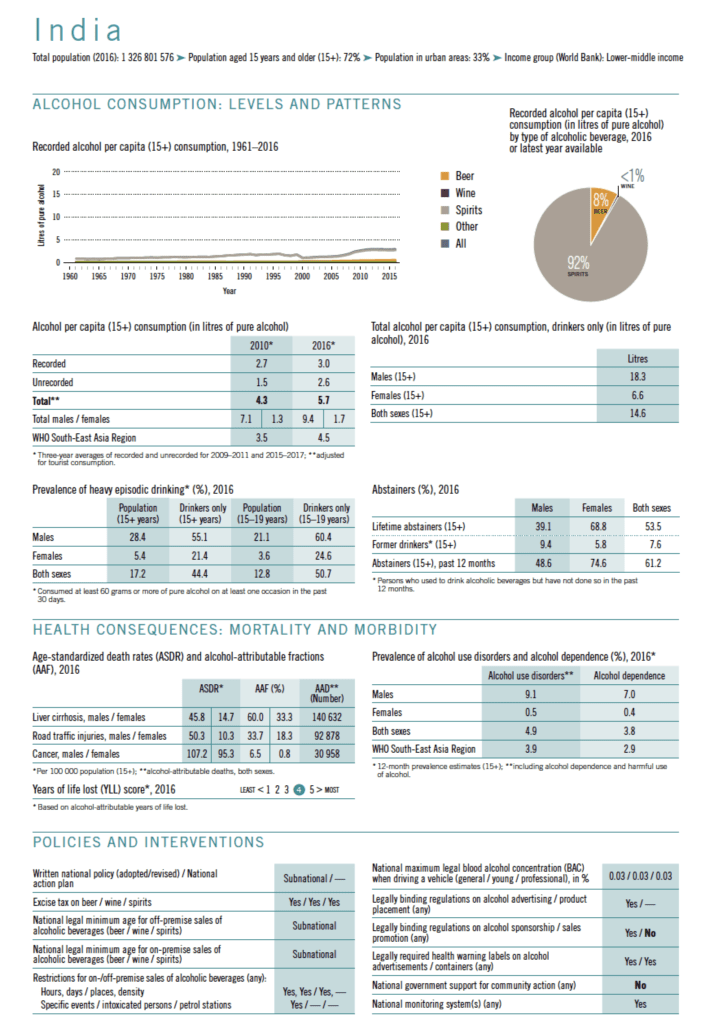In a new move making alcohol even more available in New Delhi the state excise department has reduced the number of alcohol-free or “dry” days from 21 to 3 for this year.
Accordingly, only Republic Day, Independence Day and Gandhi Jayanti will be alcohol-free days in the state. These alcohol-free days are applicable to all the licensees of the Excise department in the state except the service of alcohol to occupants in case of hotels having L-15 license.
Businesses of licensees are to be closed during “dry days”.
Previous 21 “dry” days included birth anniversaries of great leaders and religious festivals. The order says that the state government may implement other “dry” days apart from the three mandated ones from time to time.
Already in 2021, the New Delhi government made alcohol more available to young people by decreasing the legal minimum age for alcohol use from 25 years to 21 years.
Heavy alcohol burden in India
The state government in India has an unhealthy reliance on alcohol tax revenue as well. Alcohol taxes are not implemented with a public health perspective but only with an economic perspective. This was evident when lifting the temporary alcohol sales bans during COVID-19 spikes was one of the first actions states took with COVID-19 lockdown relaxation, despite alcohol’s lethal interaction with the COVID-19 pandemic.
India’s alcohol burden was already heavy before the pandemic. Since the pandemic began the lethal interaction of alcohol harm with the coronavirus has made matters worse.
- According to OECD figures, alcohol use had risen with more than 72.5% over a period of 20 years.
- In 2017, alcohol was responsible for more than 580,000 deaths in India, according to the Global Burden of Disease Study.
- The three leading causes of alcohol attributable deaths in India are tuberculosis, road injuries, and self-harm.
- According to a report by the Ministry of Social Justice and Empowerment (MoSJE) of India, every third alcohol user in India needs help for alcohol use problems and only about 1 in 38 people with alcohol dependence, report getting any treatment or help.
- A modelling study in 2019 found that economically India loses 1.45% of its GDP due to alcohol. This is more than the country’s entire health spending which is 1.28% of its GDP. In numbers, between 2011–2050 India stands to lose US$2.2 trillion – accounting for tax revenues – due to alcohol costs.
Alcohol policy in India
Despite the heavy alcohol burden in the country, most of India’s alcohol policies are regulated at the subnational level. This has led to a patchwork of policies which differ from state to state.
The alcohol industry is known to exploit the Indian alcohol policy system.
- Recently, three major alcohol multinationals were exposed for price cartellization.
- The companies were Carlsberg, AB InBev acquired SABMiller, and Heineken-controlled United Breweries (UB).
- Before that Carlesberg was exposed for bribery and child labour in India.
- In the state of Assam alcohol was used to bribe voters during elections.
- During COVID-19, Big Alcohol has been pushing state governments to allow home delivery of alcohol products. This led some states to trial various online sales methods, including a token system.
It is evident that the the existing alcohol policy system is failing to protect the Indian people from the harms caused by the products and practices of the alcohol industry. A comprehensive national alcohol policy system which prioritizes public health over commercial profits is necessary to safeguard the health and development of people, communities, and society in India.

